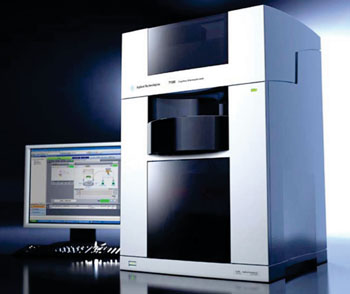Simple New Method Identifies Food Allergies
By LabMedica International staff writers
Posted on 15 Jul 2014
A highly-sensitive method has been developed that can quickly and accurately identify proteins that cause allergic reactions even at very low concentrations.Posted on 15 Jul 2014
Food allergies occur when the body's immune system mistakes a harmless food protein for a threat and attacks it as it would normally do with a bacterium or a virus and this causes symptoms like swelling, rashes, pain, and even life-threatening anaphylactic shocks.

Image: The 7100 Capillary Electrophoresis system (Photo courtesy of Agilent).
Scientists at the Ecole Polytechnique Fédérale de Lausanne (Switzerland) developed a highly-sensitive method that uses a patient's immunoglobulin E (IgE) to determine specifically which protein induces allergic responses in them. The method uses a well-established technique called immunoaffinity capillary electrophoresis (IACE). First, IgE antibodies from the patient's blood are isolated by interaction with magnetic beads that are coated with a different type of antibody.
Blood serum of a patient allergic to the cow’s milk and control serum from a blood donor who had no allergies was tested. First, IgE antibodies from the patient's blood are isolated by interaction with magnetic beads that are coated with a different type of antibody. The antibody coated bead recognizes and binds to the patient's IgE antibodies. This takes place inside a long and narrow glass tube called a capillary. The bound antibodies are then flushed out of the capillary which are powerfully attached to the magnetic beads through a process called crosslinking, and this keeps them from detaching. The beads with the patient's IgE are then placed again inside the capillary.
The IACE-UV investigations for total IgE analysis was carried out with a 7100A Capillary Electrophoresis (CE) apparatus (Agilent; Waldbronn, Germany). Component-resolved diagnostics (CRD) were performed using the IACE with Matrix Assisted Laser Desorption/Ionization Mass Spectrometry (MALDI-TOF-MS, Microflex instrument (Bruker Daltonics; Bremen, Germany). The method offers a personalized way to identify the exact proteins that can cause food allergies to a patient, which can help develop an effective treatment.
The authors concluded that their method was quicker that the laborious and resource-intensive diagnostic methods used currently as it does not require the detection and quantification of a patient's specific IgE antibodies. The methodology provides higher accuracy than conventional allergy-testing methods, as it can detect tiny amounts of allergic proteins, even if they are unexpected and rare. This also means that the method can be extended beyond milk to other foods like nuts and wheat products. The study was published on June 10, 2014, in the journal Analytical Chemistry.
Related Links:
Ecole Polytechnique Fédérale de Lausanne
Agilent
Bruker Daltonics














